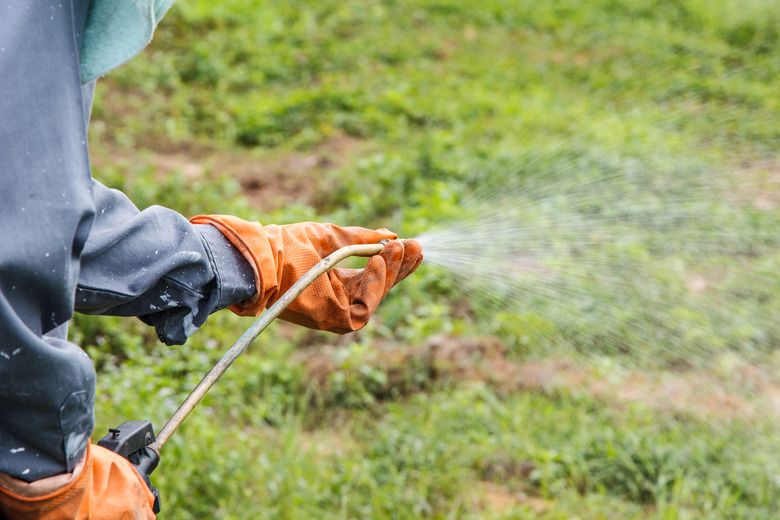Which Weed Killers Contain Triclopyr?
As gardeners become aware of the negative effects of toxins in our lives, most resolve to use as few chemicals in the garden as possible to avoid contaminating the soil or injuring wildlife, beneficial insects, other plants, humans and pets — especially weed killers that contain Triclopyr.
Synthetic chemicals used as herbicides are nonselective, which means they damage or kill almost every type of plant they contact, or they are selective, which means they damage or kill only certain weeds. Triclopyr is a selective herbicide, targeting broadleaf and woody plants instead of grassy plants. It may also be used as one ingredient in a multichemical herbicidal mix that collectively works as a nonselective herbicidal combination.
So, which weed killers contain Triclopyr, and is it safe to use?
Tip
The chemical Triclopyr is an ingredient in more than 200 commercial weed killers, including Garlon, Pathfinder, Remedy, Tailspin and Vastlan.
What Is Triclopyr?
What Is Triclopyr?
Triclopyr was initially registered for forestry. Currently, it's often used in agricultural applications, and it's also formulated for turfgrass and use around certain landscape plants.
Triclopyr is a selective herbicide. This means that it only controls certain types of plants. It's most often used to treat broadleaf weeds including poison ivy, nettles, docks, brambles, and woody plants. It is also used to kill weeds in turfgrass is because grasses tend to be less sensitive to Triclopyr than other weeds.
However, it is important to understand that Triclopyr products are non-selective when it comes to broadleaf plants. In other words, they can kill any broadleaf plants that it may contact, even inadvertently. Take care not to allow sprays to drift to desirable plants.This also applies to mature trees, since the herbicide can move through the outer bark and into the tissue the trees needs to transport water or nutrients.
How Does Triclopyr Work?
How Does Triclopyr Work?
Triclopyr works through systemic action. It enters a plant through the roots, foliage and stems and moves through to damage or, over time, to kill it. Typically, Triclopyr takes weeks to kill a plant. It is available in water-soluble concentrates, oil-soluble concentrates, and ready-to-use, oil-based concentrates.
Triclopyr is highly water-soluble, allowing it to move throughout the soil, where it may also linger. It's best for the environment to use only enough of this chemical to kill weeds and reduce its concentration in the soil.
Tip
If organic methods simply don't work to eradicate some types of persistent weeds, move to the least toxic formulations of synthetic chemicals possible.
Which Weed Killers Have Triclopyr?
Which Weed Killers Have Triclopyr?
Triclopyr is the name of the chemical agent that kills weeds, but there are more than 200 products with different trade names that contain this ingredient. Common herbicides that have Triclopyr as an active ingredient include:
- Pathfinder
- Vastlan
- Remedy
- Garlon
- Tailspin
Vastlan is an example of a product that contains Triclopyr in a water-soluble concentrate. Used alone, Vastlan can be applied to the foliage or on the cut stems of woody plants to kill them as a selective herbicide without harming grasses. However, it is also used in a mixed solution with glyphosate, and this combination kills most everything it touches, turfgrass included. Note that glyphosate is the active ingredient in Roundup, a nonselective herbicide,
Pathfinder II is an example of a product that contains triclopyr in an oil-based, ready-to-use formulation. It is often used to kill tree stumps. Garlon 4 Ultra is a product that contains triclopyr in an oil-soluble concentrate formula. commonly applied to woody-stemmed plants to kill them.
What Are Triclopyr Safety Precautions?
What Are Triclopyr Safety Precautions?
Triclopyr should only be used according to the label directions. That means a gardener must pay attention to directions regarding the rate of application, time of application, and types of weeds to target.
Although Triclopyr is not considered very toxic on skin or when inhaled, it is always best to take all precautions. Wear gloves when handling, applying, or disposing of this chemical and apply it in a way that keeps the fumes as far from you as possible.
There are forms of Triclopyr cause eye problems. Some only cause eye irritation, but other products may cause permanent eye damage. That makes it essential to wear safety goggles when handling, applying, or disposing of this chemical.
Warning
Triclopyr toxicity research primarily includes laboratory evaluation of rats, rabbits, and dogs, and its precise effects on people, such as its potential for causing cancer, have not been fully evaluated. Follow all label safety recommendations to minimize exposure and reduce the risks of exposure to Triclopyr. If you're exposed to Triclopyr, follow the first-aid instructions on the product label or call the poison control center at 800-222-1222 for treatment advice.
